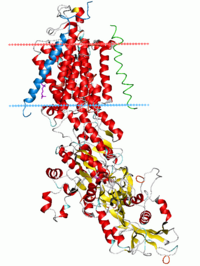
Photo from wikipedia
Kidney proximal tubules are a key segment in the reabsorption of solutes and water from the glomerular ultrafiltrate, an essential process for maintaining homeostasis in body fluid compartments. The abundant… Click to show full abstract
Kidney proximal tubules are a key segment in the reabsorption of solutes and water from the glomerular ultrafiltrate, an essential process for maintaining homeostasis in body fluid compartments. The abundant content of Na+ in the extracellular fluid determines its importance in the regulation of extracellular fluid volume, which is particularly important for different physiological processes including blood pressure control. Basolateral membranes of proximal tubule cells have the classic Na+ + K+-ATPase and the ouabain-insensitive, K+-insensitive, and furosemide-sensitive Na+-ATPase, which participate in the active Na+ reabsorption. Here, we show that nanomolar concentrations of ceramide-1 phosphate (C1P), a bioactive sphingolipid derived in biological membranes from different metabolic pathways, promotes a strong inhibitory effect on the Na+-ATPase activity (C1P50 ≈ 10 nM), leading to a 72% inhibition of the second sodium pump in the basolateral membranes. Ceramide-1-phosphate directly modulates protein kinase A and protein kinase C, which are known to be involved in the modulation of ion transporters including the renal Na+-ATPase. Conversely, we did not observe any effect on the Na+ + K+-ATPase even at a broad C1P concentration range. The significant effect of ceramide-1-phosphate revealed a new potent physiological and pathophysiological modulator for the Na+-ATPase, participating in the regulatory network involving glycero- and sphingolipids present in the basolateral membranes of kidney tubule cells.
Journal Title: Current Issues in Molecular Biology
Year Published: 2022
Link to full text (if available)
Share on Social Media: Sign Up to like & get
recommendations!